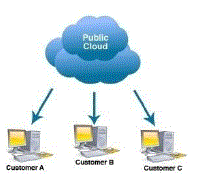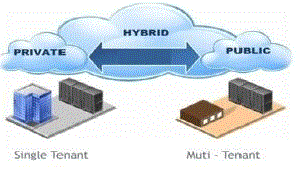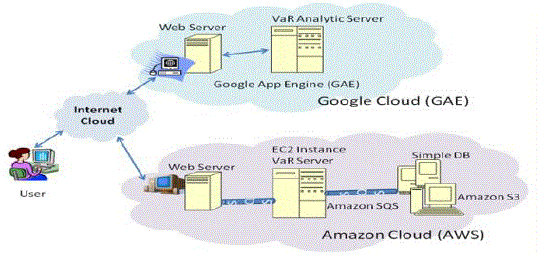Keywords
|
| Cloud Computing, Virtualization, Google App Engine, Java Web Deployment |
INTRODUCTION
|
| Cloud computing is as a service used over the network for multi- purposes like software, hardware and infrastructure as a service. There are several fields that are affected by the cloud computing like deployment. Cloud computing makes enable for the better performance using less resource. It includes delivery of the application/infrastructure has service throughout the internet and software that provide services in the data centre. The data centre, software and hardware are known as a cloud [1]. |
| The deployment of source into the cloud is not simply easy. The network connections should be persisting though started processes are getting to end. If connections are end, that will cause of the many problem. The deployment framework presently not well enough. If connection goes off mode, half of the source is deployed. This will affected application run time. The application work flow will affected. For this, a kind of the solution will suggest. Once source imported from the developer without breaking, allows upgrading application and also avoiding module scanning. Otherwise application will not reflect latest changes. This idea is going to be taken care for the deployment solution. |
CLOUD
|
| Cloud Computing is the next stage in the Internet's evolution, providing the means through which everything - from computing power to computing infrastructure, applications, business processes to personal collaboration - can be delivered as a service wherever and whenever you need [1]. |
| Cloud services include the delivery of software, infrastructure and storage over the Internet (either as separate components or a complete platform) based on user demand [2]. |
CLOUD COMPUTING SERVICE LEVELS
|
 Cloud Computing Service Levels Cloud Computing Service Levels |
| Cloud computing is three service level. [2] |
| 1) Software as a Service (SaaS) |
| 2) Platform as a Service (PaaS) |
| 3) Infrastructure as a Service (IaaS) |
DEPLOYMENT MODEL ON CLOUD
|
| The deploy cloud computing in several different ways depending upon many factors, such as: |
| ? Where the cloud services are hosted |
| ? Security requirements |
| ? Desire to share cloud services |
| ? The ability to manage some or all of the services |
| ? Customization capabilities |
| There are four common deployment models for cloud services |
| 1. Public Cloud |
| 2. Private Cloud |
| 3. Community Cloud and |
| 4. Hybrid Cloud [9] |
1. Public Cloud
|
| Available to the general public and owned by a third party cloud service provider (CSP). The computing resources over the internet from a CSP, who shares it resources with other organizations. This is most cost effective deployment model. All services are delivered with consistent availability, resiliency, security and manageability. The benefits of public cloud reduce and control monitoring over the provider’s governance and security. |
 |
2. Private Cloud
|
| It involves a distinct and secure cloud based environment in which only the specified client can operate. However, this type of cloud is only accessible by a single organization providing that organization with greater control and privacy. |
| The features and benefits of the private cloud computing are high security and privacy, more control, cost and energy efficiency, improved reliability and cloud bursting [6]. |
 |
3. Community Cloud
|
| This computing is a collaborative effort in which infrastructure is shared between several organizations from a specific community with common concerns, whether managed internally or by a third party and hosted internally. The costs are spread over fewer users than a public cloud, so only some of the cost saving potential of cloud computing are realized [8]. |
 |
4. Hybrid Cloud
|
| It is an integrated cloud service utilizing both private and public cloud to perform the distinct functions within the same organization. Therefore, an organization can maximizes their efficiencies by employing public cloud services for all non-sensitive operations, only relying on a private cloud where they require it and ensuring that all of their platforms are seamlessly integrated.[9] |
 |
BENEFITS OF CLOUD
|
| 1. Achieve economies of scale |
| 2. Reduce spending on technology infrastructure. |
| 3. Globalize your workforce on the cheap. |
| 4. Streamline process. |
| 5. Reduce capital cost. |
| 6. Improve accessibility. |
| 7. Monitor projects more effectively. |
| 8. Less personnel training is needed. |
| 9. Minimizing licensing new software. |
| 10. Improve flexibility. [3] |
REQUIREMENTS FOR DEPLOYING APPLICATION OVER NETWORK
|
1. Licensing
|
| Application is made up of many components which are associated with some license agreements [9]. Analysis should be made about the effects of those license agreements on the deployment of application on cloud. Applications which are designed licensed for CPU, when we deploy it on the cloud increases the load by exciding the CPU license limit. |
2. Process Requirements and memory locks
|
| Application should be designed to work on the parallel architectures, because of the dynamic scalability of cloud. Multi threaded code which allows process to split into small chunk suits for the cloud environment. A single threaded application cannot take a real advantage of clouds distributed nature [8]. |
3. Bandwidth Requirements
|
| The public cloud accessed via the Internet, bandwidth is significantly limited when compared to a private cloud. Public cloud’s bandwidth limitation, applications that have moderate client bandwidth requirements should only be considered [9]. |
4. Communication protocol
|
| The cloud is based on the Internet Protocol (IP), so far an application to be considered, it must use IP as its communication mechanism. While there are many protocols that can be run over IP, the use of Transport Control Protocol (TCP) is preferred. |
5. Data Security
|
| The application will need to provide security at the data storage, processing and transmission stage. Three critical components of this are: |
| • Data in transit needs to be protected either at the application or the transmission level. |
| • Data at rest must be by the application. The application must be provide a mechanism to protect the data store the cloud like encryption etc. |
| • Servers to the server communications are typically forgotten because they currently exist within the data center. |
RELATED WORKS
|
| As per the growing development of cloud computing, it’s future of the IT field. Even though there are several problem still facing in cloud computing. The issues are Performance, security, Costs, Reliability etc., if future wants accept the cloud, and then have to overcome these issues. To evaluate the performance issue, a java web-application deployed to a cloud server (Google App Engine) as below: |
DEPLOY A WEB-APPLICATION ON GOOGLE APP ENGINE
|
| 1. A java web application can be deployed on Google App Engine using the appengine-java-sdk tool. We have to configure with the appengine-java-sdk our eclipse. The installation will also setup the GWT and App Engine SDK into your Eclipse preferences. To check this use Window -> Preferences -> Google -> App Engine / Web Toolkit. [7] |
| 2. We have register with appengine.google.com with your google account and login. Then create application name Ex. MySampleApplication. |
| 3. The sample web-application is deployed and would be available on app-name.appspot.com for ease access. The Application Administration can be accessed on appengine.google.com.[5] |
| Thus a java web-application is deployed on cloud server (Google App Engine). The deployment issue is discussed in the paper which is most important issue on cloud computing for its users. The deployment issue includes the delay for running application on cloud server. The web server sends its output of the web-application to the client. If the cloud server takes longer time to run application, this would be lead to delay to reflect the changes in the application page. |
 Deploy a Web-Application on Google App Engine Deploy a Web-Application on Google App Engine |
DEPLOYMENT CHALLENGES ON CLOUD
|
| There are many issues in web-Deployment in cloud computing. Some of the issues are mentioned below, in that one of those would be undertake to overcome. |
1. Performance
|
| Cloud may lack performance in some intensive transaction oriented and other intensive applications. High latency delays may be observed by the users who are at far long distance from cloud. |
2. Security and privacy
|
| The main challenge to cloud computing is how it addresses the security and privacy concerns of businesses thinking of adopting it. The fact that valuable enterprise data will reside outside the corporate firewall raises serious concerns. These risks can be migrated by using security applications, encrypted file system, data loss software and buying security hardware to track unusual behavior across servers. |
3. Services Delivery and Billing
|
| It is difficult to assess the cost involved due to the on-demand nature of the services. Budget and assessment of the cost will be very difficult unless the provider has some good and comparable benchmarks to offer. Business will be reluctant to switch to cloud without a strong service quality guarantee. |
4. Interoperability and portability
|
| Business should have the leverage of migrating in and out of the cloud and switching providers whenever they want, and there should be no lock-in period. Cloud computing services should be the capability to integrate smoothly with the on-premise IT. |
5. Reliability and Availability
|
| Cloud providers still lack round-the-clock service; this result in frequent outage. It is important to monitor the services being provided using internal or third-party tools. It is a vital to have planned to supervise usage, SLAs, performance, robustness and the business dependency of these services. |
6. Performance and Bandwidth cost
|
| Business can save money on hardware but they have to spend more for the bandwidth. This can be low cost for smaller applications but can be significantly high for the data-intensive applications. Delivering intensive and complex data over the network requires sufficient bandwidth [10]. |
INTENTION
|
| As per the given issue formulations, the basic intention will be to conclude the less performance causes in Java-Web Application on Clouds. |
| • Following phrases would be useful in the performance issues: |
| • Choose an appropriate platform for java application like Google App Engine etc. |
| • The cloud frame work should be configured as per the requirement of the J2EE applications. |
| • The infrastructure of the cloud services should be more specific to the java applications. |
| • Below methods can be used for the above proposed objective: |
| - The structure of cloud computing in the respect of deployment should be in good manner. The framework used in the Virtual machine server should be independent and optimized for cloud be good at performance. |
| - The resources which is used in the cloud computing should be single independent resource and should mention the required configuration and should be platform independent a reliable to use at large scale. |
| These issues would be resolved by several possible solutions. In the cloud services, to perform some specific task, there are several resources arranged in particular order. The cloud computing provides us customizing its resources according to the individual application and its use. |
METHODOLOGY
|
| The methodology will used to overcome this issue would be |
• Optimization in Framework
|
| As per the Google app engine, the cloud computing has it dependency on the frame work of Web- Applications. So the very first approach would be followed the optimization of the framework of the application in cloud. The only framework, which has been customized for the cloud computing is the spring framework yet now. |
| While using Spring Framework in cloud deployment if the application takes a longer time to load, would be thrown as DeadlineExceedException and the control will be shifted to the framework and now framework would take the respective decisions. For a better Cloud Deployment the entire framework should be optimized. |
• Reducing or avoiding use of module scanning
|
| In Google App Engine, The Spring Framework processes a set of observation as a single-flag to any other object in its execution. Sometime the requested resource cannot be availed due to the resource sharing; this also restricts the application-speed in its performance. The Component Scanning is also responsible for making application with lesser performance and lesser efficient due to its time taking process. To avoid this problem, the Component Scanning would be avoided. In the mandatory case of using Component Scanning, it would be reduced. |
CONCLUSION
|
| According to the result, the performance issue can be easily handled filtering the web-application individually and the frame-work customization. This has been major issue for the cloud user which would be handled by the suggested plan. This would decrease the High Latency Delay for the application performance and the application would not take longer time to run on the cloud server. |
| |
References
|
- Judith Hurwitz, Robin Bloor, Marcia Kaufman, and Fern Halper, “ Cloud Computing For Dummies”, ISBN: 978-0-470-48470-8
- Google Developers, Google Developers Academy, Last modified: December 20, 2013
- Laurel Delaney, Verio an NTT Communication Company, News letter.
- Lars Vogel, Google App engine for java – tutorial, Version 2.7, 03 December 2010.
- Google Developers, Google Developers Academy, Last modified: November 21, 2013.
- Introduction to the cloud computing architecture white paper 1st edition 2009 by sun Microsystems.
- Cloud CioGov,Cloud Computing deployment model, 2014.
- James Kinsella, Interoute Communication, March 23, 2013.
- “The NIST Definition of Cloud Computing”, National Institute of Science and Technology, July 24, 2011.
- Jack Rosenblum, Cloudtweaks, August 27,2012.
|